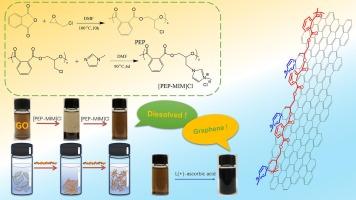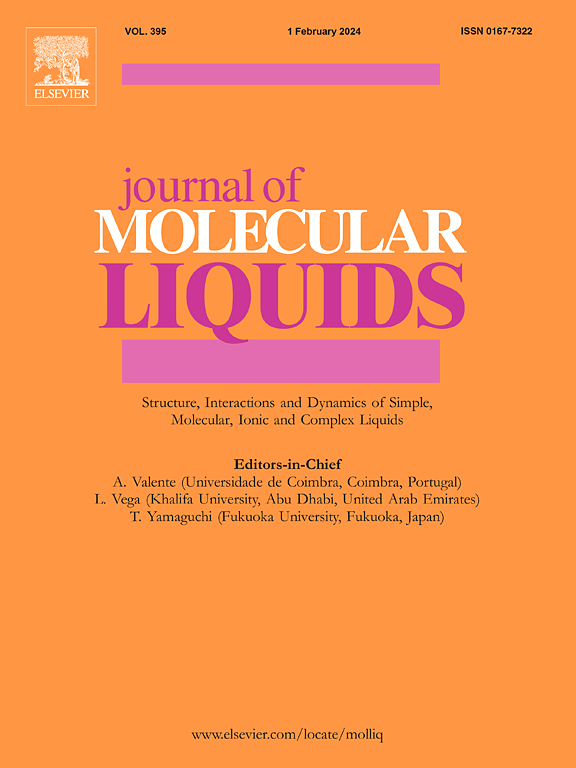Enhanced dispersion of graphene sheets in various liquid solvents supported by poly(ionic liquid) via non-covalent interaction
IF 5.3
2区 化学
Q2 CHEMISTRY, PHYSICAL
引用次数: 0
Abstract
In this study, a new method for the preparation of graphene using poly(ionic liquid) [PEP-MIM]Cl was found and the complex [PEP-MIM]Cl-GO, which combines with graphene oxide (GO) via electrostatic and π-π interactions, was investigated to be dissolved in the organic or aqueous phase, depending on the concentration of the poly(ionic liquid), and to be stably dispersed and liquid crystalline. After reduction to graphene (rGO) by L(+)-ascorbic acid, this stable dispersion can still exist without any agglomerates, and thus the poly(ionic liquid)- functionalised graphene [PEP-MIM]Cl-rGO with good dispersibility in water was prepared, and some explorations of phase transfer and anion exchange of [PEP-MIM]Cl-rGO based on the ion exchangeability of the poly(ionic liquid) were made. exchange, and the success of the preparation of poly(ionic liquid)-functionalized graphene was confirmed by TEM, AFM, FTIR, Raman and other characterizations.

通过非共价作用增强石墨烯片在聚离子液体支持的各种液体溶剂中的分散性
本研究发现了一种利用聚(离子液体)[PEP-MIM]Cl 制备石墨烯的新方法,并研究了通过静电和 π-π 相互作用与氧化石墨烯(GO)结合的复合物 [PEP-MIM]Cl-GO,该复合物可根据聚(离子液体)的浓度溶解在有机相或水相中,并稳定分散和液晶化。在用 L(+)- 抗坏血酸还原成石墨烯(rGO)后,这种稳定的分散体仍然可以存在而不产生任何团聚,因此制备出了在水中具有良好分散性的聚(离子液体)功能化石墨烯 [PEP-MIM]Cl-rGO,并根据聚(离子液体)的离子交换性对 [PEP-MIM]Cl-rGO 的相转移和阴离子交换进行了一些探索。交换,并通过 TEM、原子力显微镜、傅立叶变换红外光谱、拉曼光谱等表征证实了聚离子液体功能化石墨烯的制备成功。
本文章由计算机程序翻译,如有差异,请以英文原文为准。
求助全文
约1分钟内获得全文
求助全文
来源期刊

Journal of Molecular Liquids
化学-物理:原子、分子和化学物理
CiteScore
10.30
自引率
16.70%
发文量
2597
审稿时长
78 days
期刊介绍:
The journal includes papers in the following areas:
– Simple organic liquids and mixtures
– Ionic liquids
– Surfactant solutions (including micelles and vesicles) and liquid interfaces
– Colloidal solutions and nanoparticles
– Thermotropic and lyotropic liquid crystals
– Ferrofluids
– Water, aqueous solutions and other hydrogen-bonded liquids
– Lubricants, polymer solutions and melts
– Molten metals and salts
– Phase transitions and critical phenomena in liquids and confined fluids
– Self assembly in complex liquids.– Biomolecules in solution
The emphasis is on the molecular (or microscopic) understanding of particular liquids or liquid systems, especially concerning structure, dynamics and intermolecular forces. The experimental techniques used may include:
– Conventional spectroscopy (mid-IR and far-IR, Raman, NMR, etc.)
– Non-linear optics and time resolved spectroscopy (psec, fsec, asec, ISRS, etc.)
– Light scattering (Rayleigh, Brillouin, PCS, etc.)
– Dielectric relaxation
– X-ray and neutron scattering and diffraction.
Experimental studies, computer simulations (MD or MC) and analytical theory will be considered for publication; papers just reporting experimental results that do not contribute to the understanding of the fundamentals of molecular and ionic liquids will not be accepted. Only papers of a non-routine nature and advancing the field will be considered for publication.
 求助内容:
求助内容: 应助结果提醒方式:
应助结果提醒方式:


